quantumcomputer
Latest

IBM's latest quantum computer is a 20-qubit work of art
Last year, IBM hauled a 50-qubit quantum computer to CES. Or, rather, it brought the eye-catching bits -- an intricate collection of tubes and wires that resembled a steampunk chandelier -- and left the more cumbersome cooling and power-management parts at home. The complete system, housed at a research lab in Yorktown Heights, New York, was spread out over a large room. It was a functional but totally inelegant design, according to Bob Sutor, vice president of IBM Q Strategy and ecosystem.
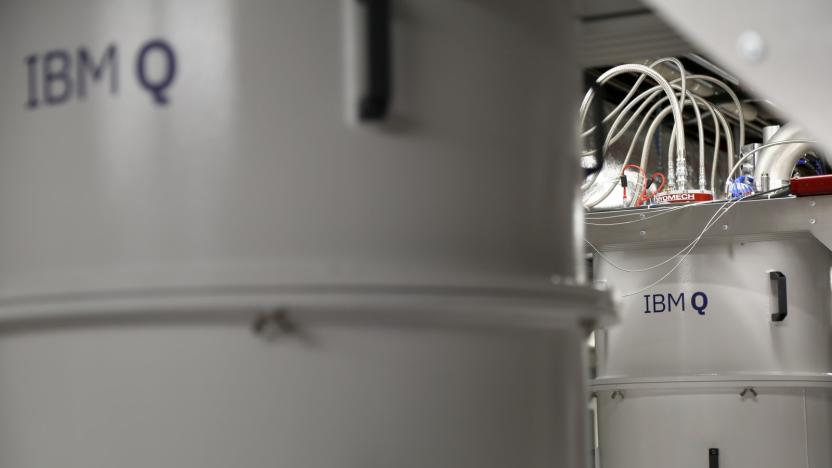
President poised to sign bill creating quantum computing initiative
Visions of an American quantum computing initiative are close to becoming a practical reality. The House of Representatives has passed its version of a bill that would establish a National Quantum Initiative Program and speed up the development of next-generation computing technology. Provided the President signs it into law (it cleared the Senate last week), the bill would set out a 10-year plan and launch several initiatives. These would include a presidential advisory committee, a National Science and Technology Council subcommittee, grants from the National Science Foundation and research at organizations ranging from the Energy Department to the National Institute of Standards and Technology.

Diamond 'guitar' strings could lead to quantum computer memory
Quantum computers need memory to perform tasks like their conventional counterparts, but it's hard to create that memory when it only takes nearby vibrating atoms to lose all their data. Scientists may have a clever solution, though: tune diamond like a guitar string. They've crafted a quantum memory system where micron-wide diamond crystal strings house impurities that are better suited to data-storing electrons. If you subject the diamond to a voltage, you can stretch it and boost the frequencies the electrons are sensitive to, much like you would tighten a guitar string to change its pitch. It'll be harder to disturb the data, in other words.
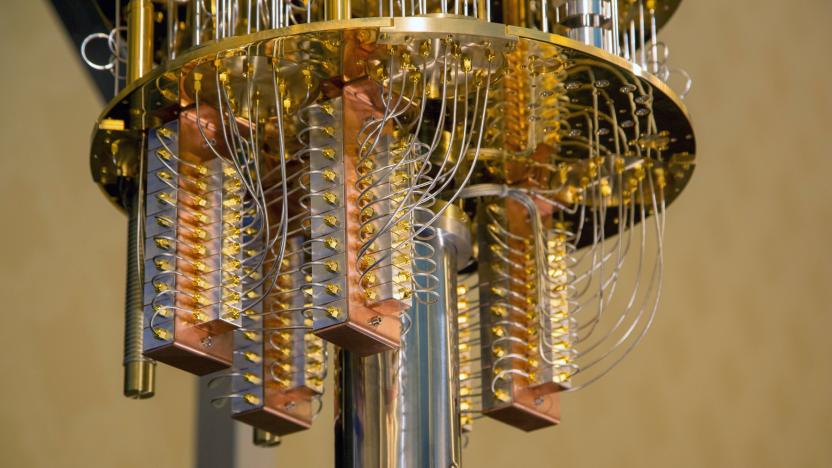
This is what a 50-qubit quantum computer looks like
From afar, it looks like a steampunk chandelier. An intricate collection of tubes and wires that culminate in a small steel cylinder at the bottom. It is, in fact, one of the most sophisticated quantum computers ever built. The processor inside has 50 quantum bits, or qubits, that process tasks in a (potentially) revolutionary way. Normally, information is created and stored as a series of ones and zeroes. Qubits can represent both values at the same time (known as superposition), which means a quantum computer can theoretically test the two simultaneously. Add more qubits and this hard-to-believe computational power increases. Last November, IBM unveiled the world's first 50-qubit quantum computer. It lives in a laboratory, inside a giant white case, with pumps to keep it cool and some traditional computers to manage the tasks or algorithms being initiated. At CES this year, the company brought the innards -- the wires and tubes required to send signals to the chip and keep the system cool -- so reporters and attendees could better understand how it works. The biggest challenge, IBM Research Vice President Jeffrey Welser told me, is isolating the chip from unwanted "noise." This includes electrical, magnetic and thermal noise -- just the temperature of the room renders the whole machine useless.
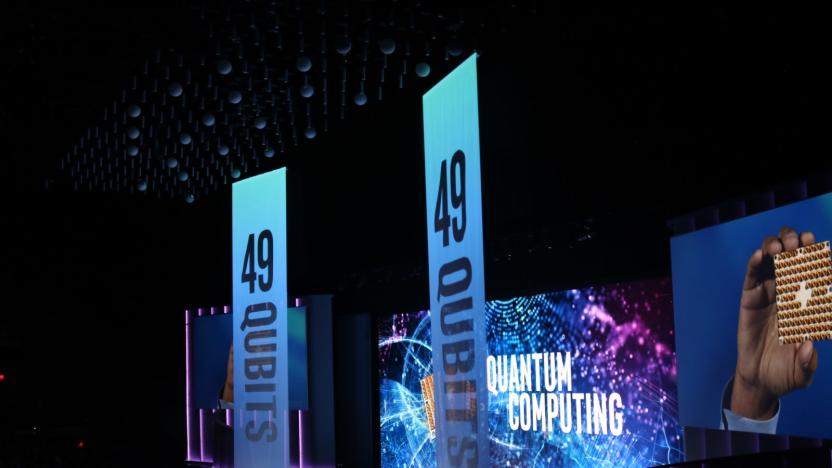
Intel’s quantum computing efforts take a major step forward
It's been almost three months since Intel announced a 17-qubit superconducting chip, meant to pave the way for a future powered by quantum computers. Today at CES, Intel CEO Brian Krzanich showed off its latest superconducting test chip, the 49-qubit Tangle Lake.
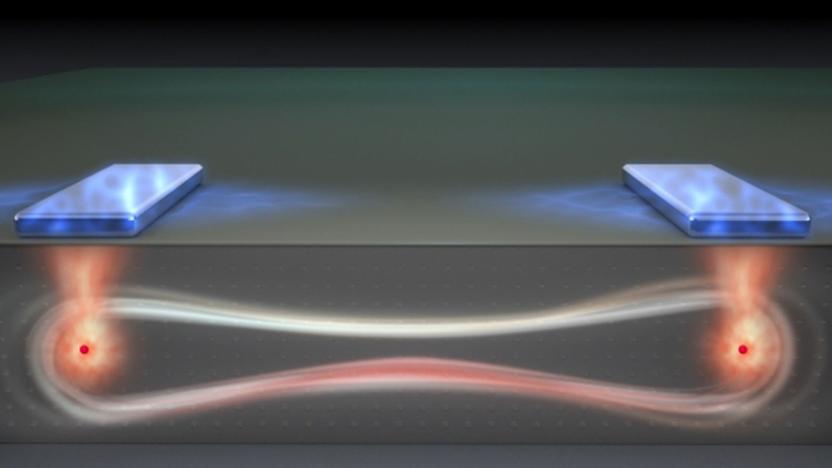
'Flip-flop' design makes quantum computers more affordable
One of the greatest challenges in quantum computing is... well, making the computers. You may need exotic manufacturing techniques just to handle the very exacting requirements, such as positioning the atoms in quantum bits in exact positions at close distances (to make quantum entanglement happen). However, that might not be a problem going forward. Australian researchers have developed a new chip design that could be built using the same silicon technology that you see in use today.
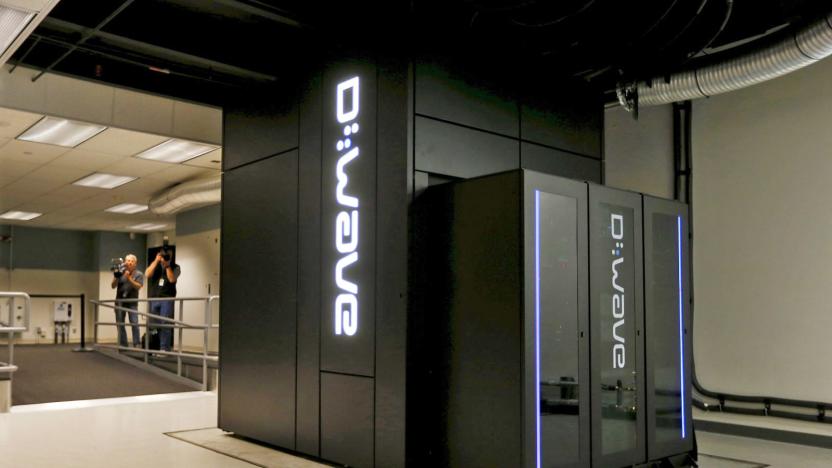
Google wants to sell quantum computing in the cloud
Whether or not you believe Google has honest-to-goodness quantum computers, the bigger problem is their limited access: they're largely off-limits outside of the company itself. That could change sooner than you think, though. Bloomberg sources understand that Google is gearing up toward using its quantum systems in a "faster, more powerful" computing service than it offers today. It recently started offering access to researchers in order to spur development of tools and apps (including through an open source Project Q initiative), and there's a new lab it describes as an "embryonic quantum data center." It's looking at the practical realities of quantum computing, in other words.

Silicon-laced diamonds could lead to practical quantum computers
Scientists already believe that diamonds could be a solid foundation for practical quantum computers. You can use atom-scale defects in diamond to store quantum bits that hold contradictory data (say, both on and off) in a way that lets you read the data without the risk of changing it. But there's a problem. The most common defect, where nitrogen atoms replace carbon atoms, emits such a broad range of light that it's too inaccurate to be useful. However, a team of researchers may have a way to keep those inaccuracies to a minimum: slip in some silicon, which emits a much narrower range of light.
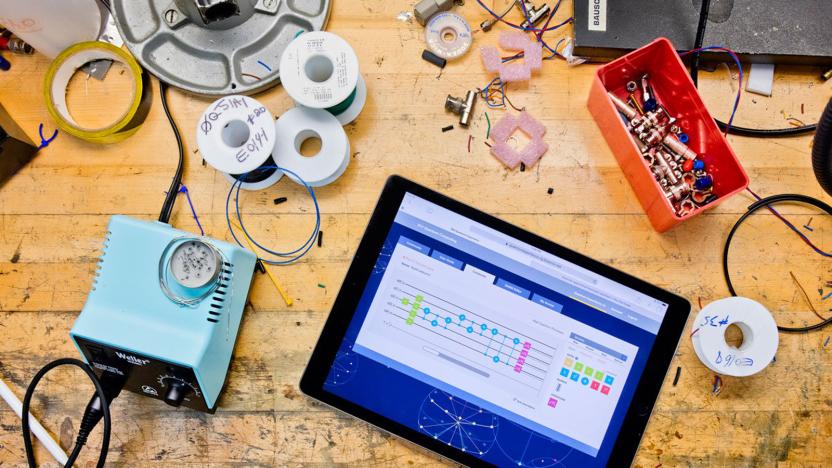
IBM plans to build a universal quantum computer
Companies can technically buy a quantum computer right now, but it's not really the same as a general-purpose computer. Even if you don't question whether or not it is quantum computing, it really amounts to specialized hardware. However, IBM hopes to change all that: it's planning to build the first commercially-oriented universal quantum computer. The plan is to build a system with roughly 50 quantum bits (the Quantum Experience started with 5 and now simulates 20) within the next few years. That may not sound like much, but 50 qubits could be more powerful than the best supercomputers when handling some calculations -- tasks that were impractical before would suddenly be within reach.

Scientists hold the first quantum computer face-off
For the first time ever, two quantum computers have faced off against each other in a series of experiments to determine which technology reigns supreme. A team of researchers from the University of Maryland have pitted their own quantum computer against IBM's creation, running the same algorithms on both at the same time. The winner? Well, it's kind of a tie. IBM's is faster than Maryland's, but it's also much less accurate. In one test, Maryland got 77.1 percent in accuracy, while IBM only got 35.1 percent. IBM's, however, was up to 1,000 faster than its competitor.
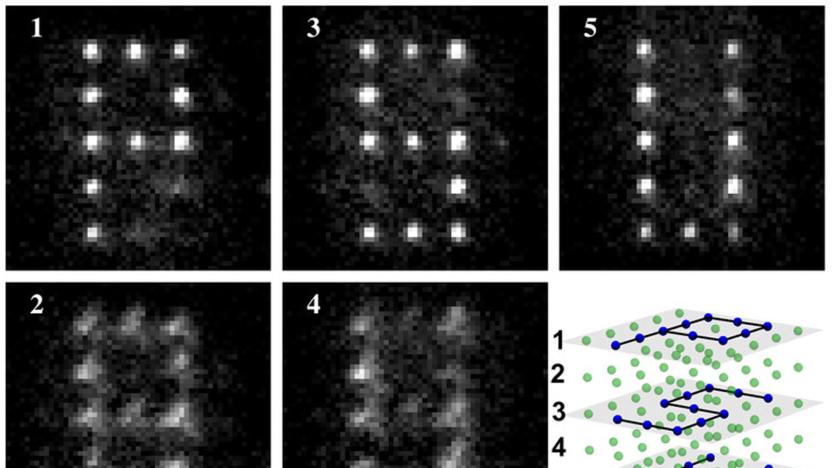
Lasers and microwaves lead to better quantum computing circuits
If you're going to craft a quantum computer, you need to corral lots of quantum bits (qubits) to perform calculations... and Penn State researchers have found a way to make that happen. They've developed a technique that relies on lasers and microwaves to steer a tightly packed, 3D grid of atoms that serve as qubits. When you want to change the state of these atoms, you hit them with crossed laser beams and then bathe them in uniform microwaves. In a test, scientists had enough control to spell out "PSU" across a three-layer array of 125 atoms.

IBM opens its quantum computer to the public
Want to use a real, honest-to-goodness quantum computer yourself? Now's your chance. IBM has introduced a cloud-based platform, the Quantum Experience, that lets anyone try a 5-qubit quantum computer for themselves. You can run algorithms and experiments, try simulations and tutorials or even work with the individual qubits. This isn't a truly universal machine, but it'll show you at least some of what non-binary computing can do.

Canada's prime minister schools reporter on quantum computing
Justin Trudeau, Canada's prime minister, paid a visit to the Perimeter for Theoretical Physics in Waterloo earlier today. There, he encountered a sassy reporter who seemingly didn't expect him to know much about quantum computing. But, as it turns out, Trudeau is well-versed on the topic, so he took the opportunity to break it down for everyone the event.

D-Wave's quantum computer overcomes key math challenge, doesn't silence skeptics
D-Wave has long wanted to show that its quantum computing technology is the real deal, and it may have just come closer to proving its case. The company now says that its computer has calculated Ramsey numbers, or solutions to optimization-based math problems that are sometimes difficult to find using traditional systems. The computation represented one of the biggest-ever implementations of an algorithm, according to researchers. However, the feat isn't necessarily proof of quantum computing at work. As Wired explains, we've seen all of these numbers in previous experiments; the challenge wasn't difficult enough to require the involvement of a quantum computer. However, D-Wave may have better evidence in the future. Its third-generation system, due in 2015, should have enough power to find Ramsay numbers that are theoretically impossible to calculate today.

USC finds that D-Wave's quantum computer is real, maybe
D-Wave has had little trouble lining up customers for its quantum computer, but questions have persisted as to whether or not the machine is performing quantum math in the first place. University of Southern California researchers have tested Lockheed Martin's unit to help settle that debate, and they believe that D-Wave's computer could be the real deal -- or rather, that it isn't obviously cheating. They've shown that the system isn't based on simulated annealing, which relies on traditional physics for number crunching. The device is at least "consistent" with true quantum annealing, although there's no proof that this is what's going on; it may be using other shortcuts. Whether or not D-Wave built a full-fledged quantum computer, the resulting output is credible enough that customers won't feel much in the way of buyer's remorse.

Researchers create working quantum bit in silicon, pave way for PCs of the future
If you've been paying attention, you know the quantum computing revolution is coming -- and so far the world has a mini quantum network, not to mention the $10,000 D-Wave One, to show for it. Researchers from the University of Melbourne and University College, London, have now developed the "first working quantum bit based on a single atom of silicon." By measuring and manipulating the magnetic orientation, or spin, of an electron bound to a phosphorus atom embedded in a silicon chip, the scientists were able to both read and write information, forming a qubit, the basic unit of data for quantum computing. The team used a silicon transistor, which detects the electron's spin and captures its energy when the spin's direction is "up." Once the electron is in the transistor, scientists can change its spin state any way they choose, effectively "writing" information and giving them control of the quantum bit. The next step will be combing two qubits into a logic step, with the ultimate goal being a full-fledged quantum computer capable of crunching numbers, cracking encryption codes and modeling molecules that would put even supercomputers to shame. But, you know, baby steps.

CCNY, UC Berkeley develop lasers that could rewrite quantum chips, spin those atoms right round
Computers are normally limited by the fixed nature of their chipsets: once the silicon is out of the factory, its capabilities are forever locked in. The City College of New York and University of California Berkeley have jointly developed a technique that could break chips free of these prisons and speed along quantum computing. They found that hitting gallium arsenide with a laser light pattern aligns the spins of the atoms under the rays, creating a spintronic circuit that can re-map at a moment's notice. The laser could be vital to quantum computers, which can depend heavily or exclusively on spintronics to work: a simple shine could get electrons storing a much wider range of numbers and consequently handling many more calculations at once. Research is only just now becoming public, however; even though gallium arsenide is common in modern technology, we'll need to be patient before we find quantum PCs at the local big-box retail chain. Despite this, we could still be looking at an early step in a shift from computers with many single-purpose components to the abstracted, all-powerful quantum machines we've held in our science fiction dreams.

Flawed diamonds are perfect ingredients for quantum computing, just add time travel
Ready to suspend your brain cells in a superposition of disbelief? Good, because the latest news published in Nature is that diamonds are a quantum computer's best friend -- particularly if they're flawed. An international team of scientists sought out sub-atomic impurities in a 1mm-thick fragment of over-priced carbon and used these as qubits to perform successful calculations. A "rogue" nitrogen nucleus provided one qubit, while a free electron became a second. Unlike previous attempts at solid-state quantum computing, this new effort used an extra technique to protect the system from decoherence errors: microwave pulses were fired at the electron qubit to "time-reverse" inconsistencies in its spinning motion. Don't fully get it? Us neither. In any case, it probably won't stop jewellers tut-tutting to themselves.

Yale Physicists develop quantum computing error correction, are a qubit pleased with themselves
We're big fans of quantum computing, and hopefully it's about to get a lot more reliable. Researchers at Yale have demonstrated quantum error correction in a solid state system for the first time. Quantum bits were created from "artificial" atoms using superconducting circuits, these qubits are then given either of the typical bit states of "1" or "0," or the quantum state of both simultaneously. The researchers developed a technique that identifies each qubit's initial state, so any erroneous changes can be reversed on the fly. Until now, errors have been a barrier in quantum computing, accumulating and ultimately causing computational failure. A reliable means of fixing these state changes is essential to developing a computer with an exponential speed-up, and fully realizing the quantum dream. The team at Yale hopes that this research might mean its platform of superconducting circuits becomes the one upon which quantum computing is ultimately built. We, on the other hand, just want our parallel universe.

Researchers wed quantum processor with quantum memory, quaziness ensues
Quantum computing has a long way to go before becoming truly mainstream, but that certainly hasn't stopped us from indulging in dreams of a qubit-based existence. The latest bit of fantasy fodder comes from the University of California, Santa Barbara, where researchers have become the first to combine a quantum processor with memory mechanisms on a single chip. To do this, Matteo Mariantoni and his team of scientists connected two qubits with a quantum bus and linked each of them to a memory element, capable of storing their current values in the same way that RAM stores data on conventional computers. These qubit-memory links also contained arrays of resonators -- jagged, yet easily controlled circuits that can store values for shorter periods of time. The qubits, meanwhile, were constructed using superconducting circuits, allowing the UCSB team to nestle their qubits even closer together, in accordance with the von Neumann architecture that governs most commercial computers. Once everything was in place, the researchers used their system to run complex algorithms and operations that could be eventually used to decode data encryption. The next step, of course, is to scale up the design, though Mariantoni says that shouldn't be too much of a problem, thanks to his system's resonators -- which, according to him, "represent the future of quantum computing with integrated circuits."








